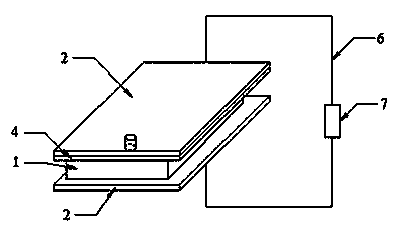Dye-sensitized solar cell for recovering energy from sewage
A technology for solar cells and energy recovery, applied in the field of dye-sensitized solar cells, can solve problems such as difficulty in using sewage and uncommon electron pairs, and achieve the advantages of long service life, improved electron yield, and accelerated degradation of organic pollutants. Effect
- Summary
- Abstract
- Description
- Claims
- Application Information
AI Technical Summary
Problems solved by technology
Method used
Image
Examples
Embodiment 1
[0031] Example 1 Preparation of anode 3
[0032] 1) Add 6g of polyvinyl alcohol (PVA) to 14mL of boiled distilled water and stir vigorously to obtain a highly viscous liquid, which is diluted in a mixed solvent consisting of 18mL of distilled water and 25mL of ethanol at 70°C.
[0033] 2) Add 1.62g of the prepared Ag / AgCl-loaded chiral TiO to the PVA / water / ethanol solution obtained in step 1) 2 nanotubes, resulting in a suspension and cooling at room temperature.
[0034]3) The suspension obtained in step 2) was uniformly coated on the FTO glass using the doctor blade coating technique (area 3 cm × 3 cm), and the resulting film was placed in a clean box for 15 min to reduce surface irregularities and coating. The residual mechanical stress of the layer. The thickness of the anodic film was 11 μm, which was controlled by the number of times the knife coating technique was repeated.
[0035] 4) The diaphragm obtained in step 3) was heated and dried in a vacuum drying oven for...
Embodiment 2
[0037] Example 2 P / TiO 2 - Preparation of Pt cathode 4
[0038] Method is the same as Example 1, and difference is that P / TiO is added in PVA / water / ethanol solution 2 After -Pt, repeat steps 2) to 4) of the above-mentioned embodiment 1.
Embodiment 3
[0039] The pretreatment of embodiment 3 FTO conductive glass substrates
[0040] The FTO conductive glass was ultrasonically cleaned in 2-propanol for 30 min, rinsed thoroughly with distilled water, and finally dried in nitrogen.
PUM
| Property | Measurement | Unit |
|---|---|---|
| Thickness | aaaaa | aaaaa |
Abstract
Description
Claims
Application Information
 Login to View More
Login to View More - R&D
- Intellectual Property
- Life Sciences
- Materials
- Tech Scout
- Unparalleled Data Quality
- Higher Quality Content
- 60% Fewer Hallucinations
Browse by: Latest US Patents, China's latest patents, Technical Efficacy Thesaurus, Application Domain, Technology Topic, Popular Technical Reports.
© 2025 PatSnap. All rights reserved.Legal|Privacy policy|Modern Slavery Act Transparency Statement|Sitemap|About US| Contact US: help@patsnap.com


